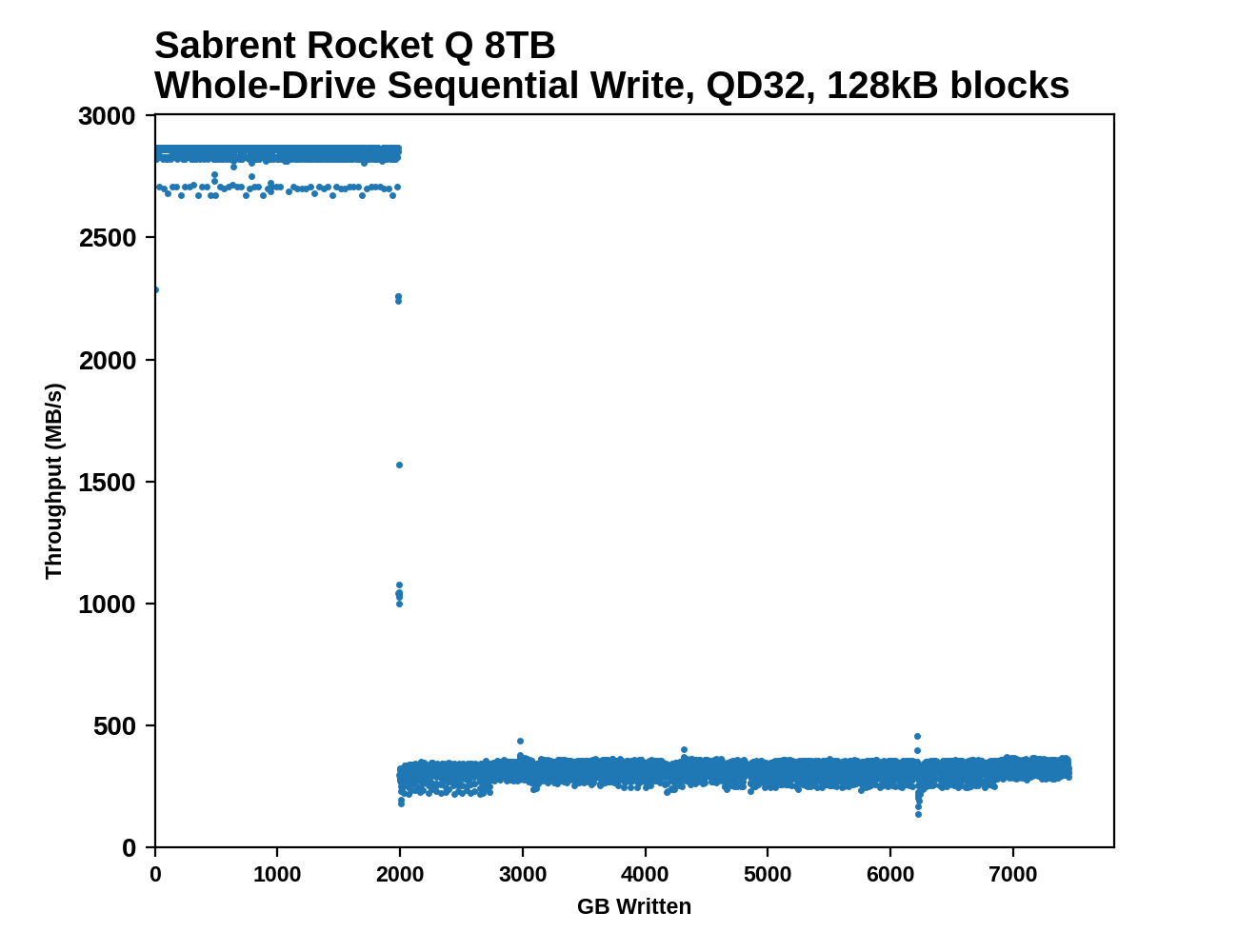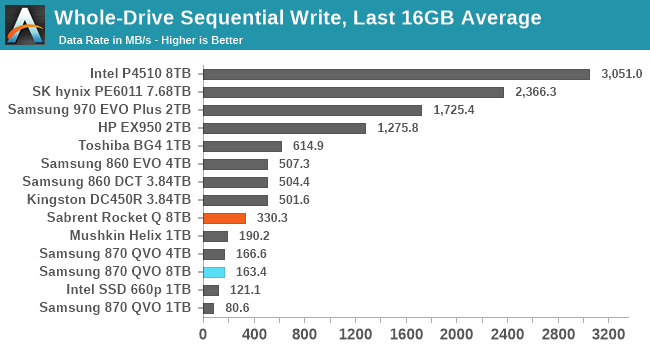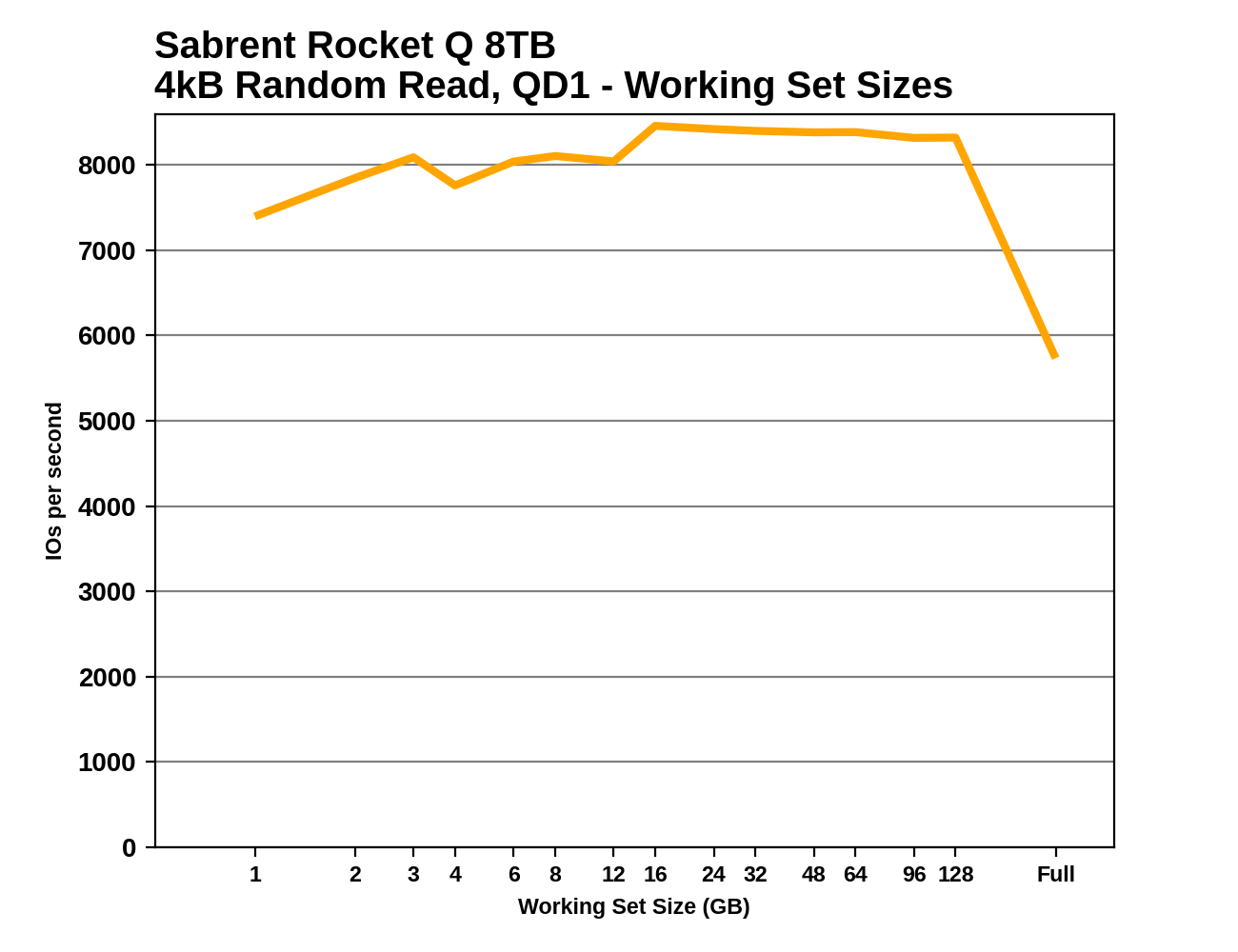QLC Goes To 8TB: Samsung 870 QVO and Sabrent Rocket Q 8TB SSDs Reviewed
by Billy Tallis on December 4, 2020 8:00 AM ESTWhole-Drive Fill
This test starts with a freshly-erased drive and fills it with 128kB sequential writes at queue depth 32, recording the write speed for each 1GB segment. This test is not representative of any ordinary client/consumer usage pattern, but it does allow us to observe transitions in the drive's behavior as it fills up. This can allow us to estimate the size of any SLC write cache, and get a sense for how much performance remains on the rare occasions where real-world usage keeps writing data after filling the cache.
 |
|||||||||
The Sabrent Rocket Q takes the strategy of providing the largest practical SLC cache size, which in this case is a whopping 2TB. The Samsung 870 QVO takes the opposite (and less common for QLC drives) approach of limiting the SLC cache to just 78GB, the same as on the 2TB and 4TB models.
 |
|||||||||
| Average Throughput for last 16 GB | Overall Average Throughput | ||||||||
Both drives maintain fairly steady write performance after their caches run out, but the Sabrent Rocket Q's post-cache write speed is twice as high. The post-cache write speed of the Rocket Q is still a bit slower than a TLC SATA drive, and is just a fraction of what's typical for TLC NVMe SSDs.
On paper, Samsung's 92L QLC is capable of a program throughput of 18MB/s per die, and the 8TB 870 QVO has 64 of those dies, for an aggregate theoretical write throughput of over 1GB/s. SLC caching can account for some of the performance loss, but the lack of performance scaling beyond the 2TB model is a controller limitation rather than a NAND limitation. The Rocket Q is affected by a similar limitation, but also benefits from QLC NAND with a considerably higher program throughput of 30MB/s per die.
Working Set Size
Most mainstream SSDs have enough DRAM to store the entire mapping table that translates logical block addresses into physical flash memory addresses. DRAMless drives only have small buffers to cache a portion of this mapping information. Some NVMe SSDs support the Host Memory Buffer feature and can borrow a piece of the host system's DRAM for this cache rather needing lots of on-controller memory.
When accessing a logical block whose mapping is not cached, the drive needs to read the mapping from the full table stored on the flash memory before it can read the user data stored at that logical block. This adds extra latency to read operations and in the worst case may double random read latency.
We can see the effects of the size of any mapping buffer by performing random reads from different sized portions of the drive. When performing random reads from a small slice of the drive, we expect the mappings to all fit in the cache, and when performing random reads from the entire drive, we expect mostly cache misses.
When performing this test on mainstream drives with a full-sized DRAM cache, we expect performance to be generally constant regardless of the working set size, or for performance to drop only slightly as the working set size increases.
 |
|||||||||
The Sabrent Rocket Q's random read performance is unusually unsteady at small working set sizes, but levels out at a bit over 8k IOPS for working set sizes of at least 16GB. Reads scattered across the entire drive do show a substantial drop in performance, due to the limited size of the DRAM buffer on this drive.
The Samsung drive has the full 8GB of DRAM and can keep the entire drive's address mapping mapping table in RAM, so its random read performance does not vary with working set size. However, it's clearly slower than the smaller capacities of the 870 QVO; there's some extra overhead in connecting this much flash to a 4-channel controller.










150 Comments
View All Comments
shabby - Friday, December 4, 2020 - link
Go home qlc ssd manufacturers, you're drunk!Oxford Guy - Friday, December 4, 2020 - link
The market doesn't care what we want. It's driven by the manufacturers. That's the way most of tech is because of duopoly, triopoly power and the high cost of owning fabs. They get to dictate to us which is not the way consumerist capitalism is supposed to work.Oxford Guy - Friday, December 4, 2020 - link
There is also consumer ignorance. Go to a site that pushes product, like slickdeals, and you won't find the type of NAND listed in the listing for their SSD "deals". Everything is just an "SSD". Manufacturers are counting on consumer ignorance.Zim - Saturday, December 5, 2020 - link
Not true. Every one of those deals has people saying no to QLC. People still buy it because it's cheap.SirDragonClaw - Saturday, December 5, 2020 - link
Not true. 99.9% of people wouldn't even know what QLC means.ahtoh - Sunday, December 6, 2020 - link
Not true. I'd say 50% at least. People who buy SSDs (or parts in general) are more educated and probably know what they're doing.s.yu - Sunday, December 6, 2020 - link
"Parts"Ah that actually makes it sound pretty sophisticated :)
at_clucks - Monday, December 7, 2020 - link
50% of people know what QLC means? Is that a joke? 50% of ATers don't understand what that means. Most consumers who even heard of the term think it's just another type of LC, the more LCs the better right? No, almost no consumer knows what that means, it's a tech spec, they may know it's not the best out there but that's it But if the price is good they won't care.Product listings are marketing fluff and BS sprinkled with plenty of concepts no regular user will even understand because they sound fancy (like TWD and ECC), they will list stuff that the average consumer can understand and relate to - capacity, speed (lots of megabytes per second, thousands of them, eye catchy), and maybe the interface because they have to (again, in an eye catching way like "SATA 6.0 Gb/s"). Even if there is a Q in the product model almost nobody cares about that.
Search for QVO on Amazon and you'll see stuff like "RELIABLE AND SUSTAINABLE: The capacity of the 8TB 870 QVO increases reliability up to 2,880 TBW using a refined ECC algorithm for stable performance".
DigitalFreak - Monday, December 7, 2020 - link
Market these "Q"LC drives to Trump supporters and watch them fly off the shelves.peevee - Wednesday, December 9, 2020 - link
Oh, you gamer kidding are so smart and sophisticated, you even know the sacred secret of what QLC means! Do you know what 2+2 is? Then you deserve the Fields medal!We, engineers with decades of experience engineering this world, who thought that exactly 0 consumer applications and not more than 1% of enterprise applications require sustained write speeds over 300MB/s, bow before you!
Don't forget to ask for extra tip next time you serve me coffee.